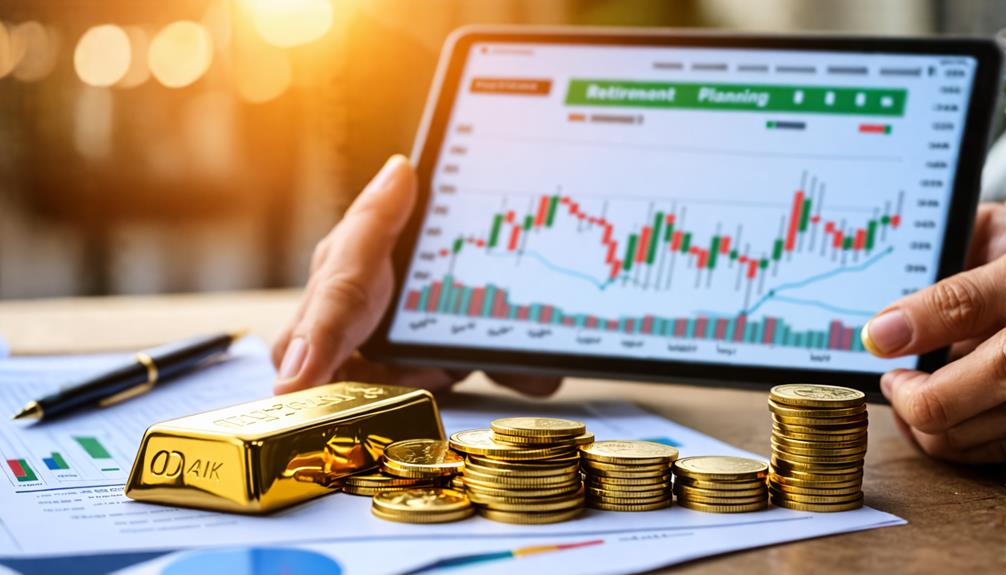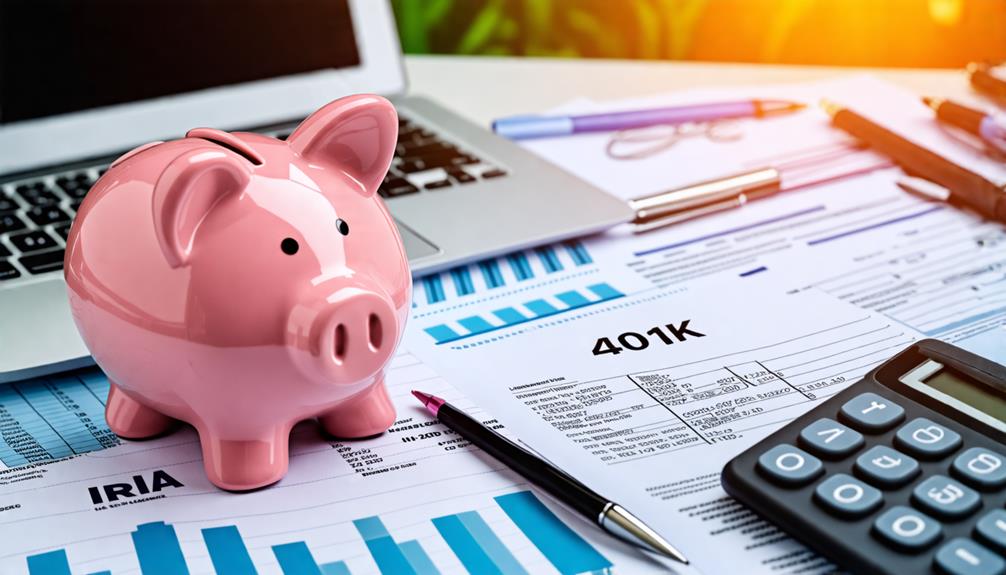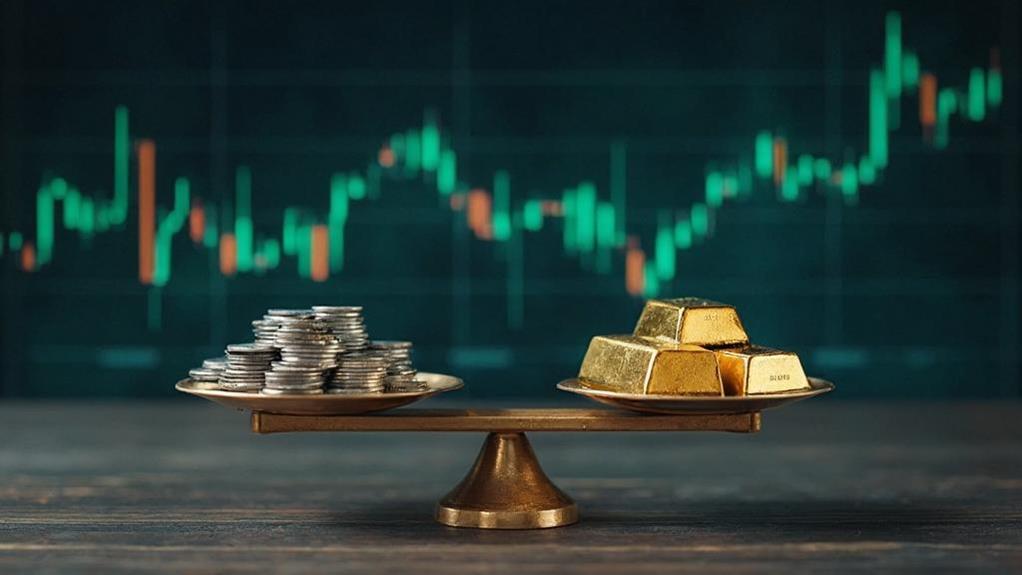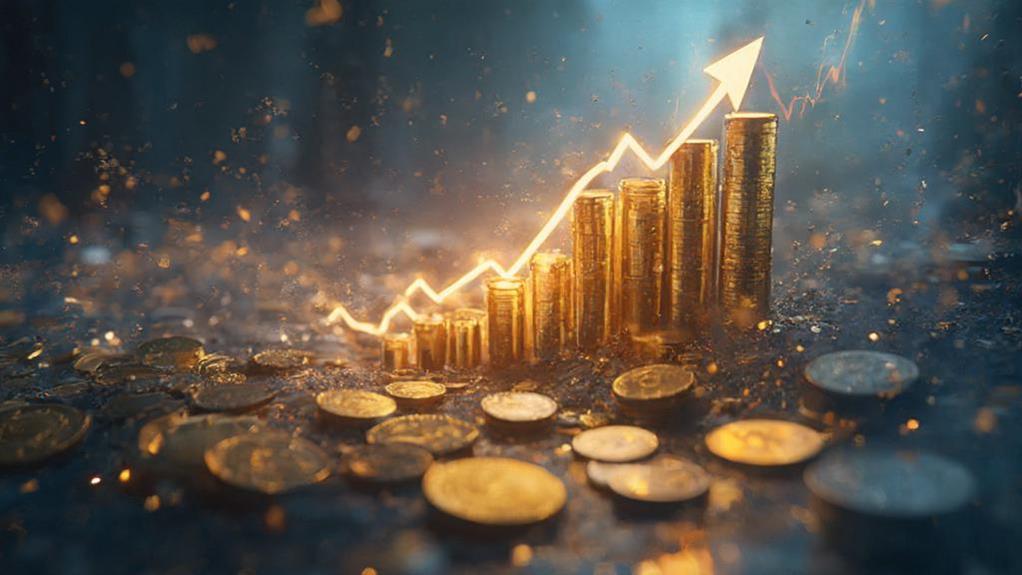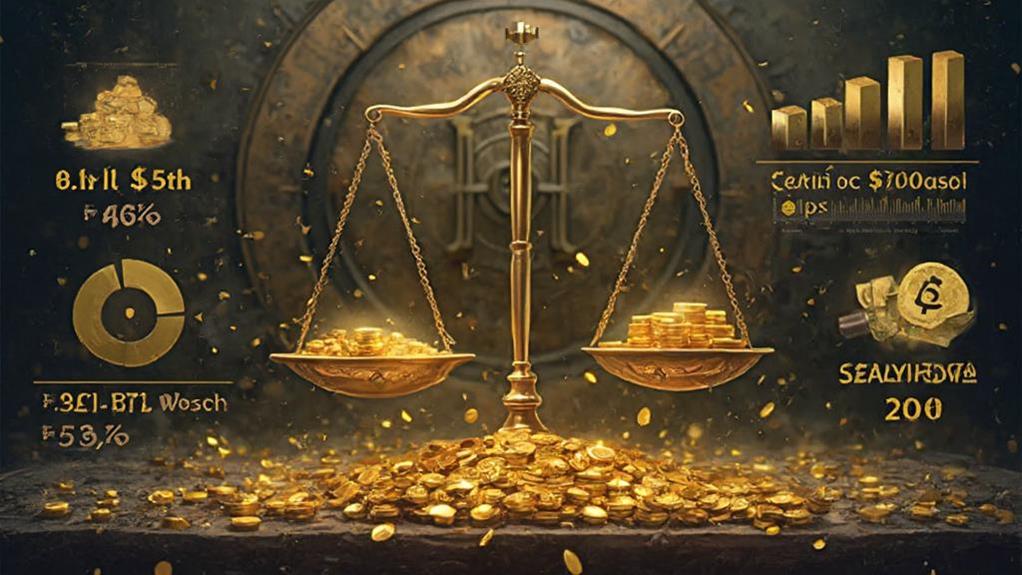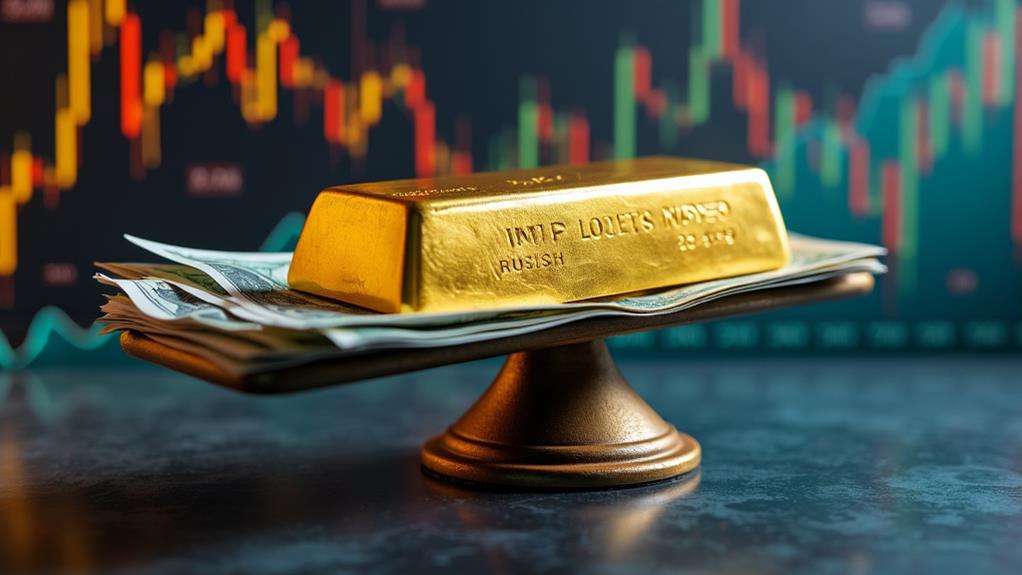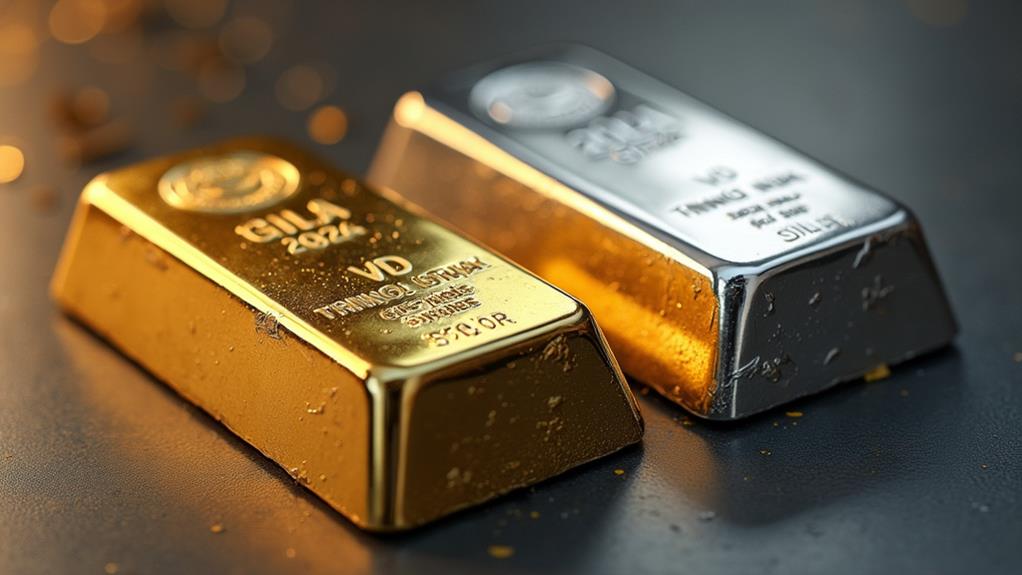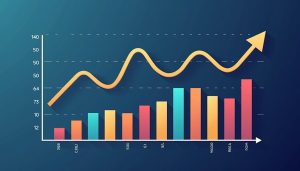Yes, you can lose money investing in gold due to its price volatility, which can swing dramatically based on global events and economic data. Storage and insurance costs add up, eating into your returns. Gold doesn’t generate passive income like dividends or interest, so you rely solely on capital appreciation. Economic and political factors can impact gold prices, sometimes leading to underperformance. Limited liquidity and additional costs like dealer premiums can also affect your gains. Emotional investing can exacerbate losses, leading to poor decisions. To explore these potential downsides in more detail, keep going.
Price Volatility
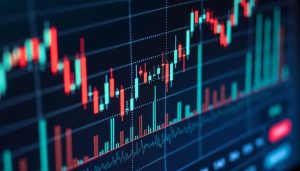
Navigating gold’s price volatility is an essential aspect of investing in this precious metal. Gold prices can be particularly unpredictable, with historical swings of up to 30% in a single year.
For instance, in 2020, gold prices soared to a record high of over $2,000 per ounce, only to drop by more than 10% within a few months. Such rapid fluctuations can lead to potential capital loss, making it important to understand the factors driving this volatility.
Economic data, geopolitical events, and investor sentiment play significant roles in influencing gold prices. Economic indicators, like inflation rates and employment figures, can cause shifts in gold’s value.
Geopolitical events, such as conflicts or trade disputes, often lead to market instability, further impacting prices. Investor sentiment, driven by fear or optimism, can also lead to sudden price changes.
Storage and Insurance Costs

Beyond grappling with price volatility, another aspect that can eat into your returns when investing in gold is the cost of storage and insurance. Storing physical gold isn’t free; you’ll typically encounter storage costs ranging from 0.5% to 1% of your holdings annually. These costs can heavily impact your potential profits over time.
To safeguard your gold, you might opt for secure storage options like vaults or safe deposit boxes, but keep in mind that these come with additional vault fees.
Insurance expenses are another consideration. Protecting your gold from theft or damage can add another 0.1% to 0.2% to your annual costs. While these expenses are important for peace of mind, they further diminish the profitability of your investment.
When you tally up the storage and insurance costs, you’ll see how they can eat into your returns, making it important to factor them into your overall strategy.
For investors seeking control and maximizing returns, understanding these costs is crucial. Knowing the impact on profitability allows you to make informed decisions about whether the potential profits from gold investments outweigh the expenses associated with safeguarding and insuring your assets.
No Passive Income

Investing in gold doesn’t produce passive income, which is a notable drawback compared to other assets like stocks or bonds. When you purchase stocks, you can earn dividends, and bonds typically pay interest, providing you with regular cash flow. However, physical gold is a non-income generating asset. It offers no periodic payments, so you won’t see any dividends or interest accumulating in your account.
This lack of passive income means you’re solely reliant on capital appreciation for returns. Fundamentally, you have to wait for the price of gold to increase to realize any profit. Unlike real estate, which can generate rental income, or dividend-paying stocks, gold doesn’t provide a consistent stream of income.
This can be a downside if you’re seeking an investment that offers regular cash flow.
For those who desire control over their financial future, the absence of passive income from gold can be a notable limitation. While gold might offer some capital appreciation over time, it doesn’t help with immediate income needs. If you’re aiming for consistent, income-producing assets, gold mightn’t align with your investment goals due to its lack of passive income.
Economic Factors

When you immerse yourself in the world of gold investments, you can’t ignore the significant impact of economic factors. Inflation, interest rates, and economic growth play pivotal roles in determining gold prices. For instance, when inflation rises, gold often becomes a hedge against currency devaluation, potentially boosting its value. Conversely, high interest rates can make gold less appealing since it doesn’t yield any interest or dividends.
Economic Factor | Impact on Gold
— | —
Inflation | Increases gold prices as a hedge
Interest Rates | Decreases attractiveness of gold
Economic Growth | Can lead to decreased gold demand
Changes in currency values and global economic conditions also directly affect gold prices. For example, if the U.S. dollar strengthens, gold prices may drop as it becomes more expensive in other currencies. Additionally, monetary policies set by central banks influence gold’s allure. Looser policies may spur inflation, making gold more attractive.
Economic downturns can lead to decreased demand for gold, impacting its price and potential returns. Understanding economic indicators and market trends is essential for managing risks. Keep an eye on fluctuations in stock markets and bond yields, as these can also impact your gold investments. Stay informed and proactive to retain control over your investment outcomes.
Political Risks
While economic factors play an important role in gold investments, political risks can’t be overlooked either. Geopolitical tensions, such as wars or elections, can drive safe-haven demand for gold, causing price fluctuations that directly affect your investment returns. When markets perceive uncertainty, such as from unexpected geopolitical developments, gold prices often react swiftly, sometimes unpredictably.
You need to pay close attention to trade policy shifts and new legislation, as these can introduce uncertainty and influence market sentiment. For example, if a major gold-producing country enacts strict export controls, global gold prices could spike, impacting your investment strategy.
Conversely, easing trade tensions might lower the perceived need for gold as a safe-haven asset, causing prices to drop.
Staying informed about political risks is essential for maintaining control over your investments. Monitor international news and political developments to anticipate how these factors might affect gold prices. Understanding the interplay between political events and market sentiment can help you make more informed decisions, reducing the chances of unexpected losses. By being proactive, you can better navigate the uncertainties that come with investing in gold and protect your investment returns.
Counterparty Risk
Counterparty risk is a critical factor when investing in gold. When you choose physical gold, you minimize counterparty risk because its value isn’t dependent on a third party. Physical gold’s intrinsic value means its worth isn’t tied to the performance of a specific entity, providing you with greater security in your investment.
In contrast, investments like paper gold, which include gold ETFs and futures, do involve counterparty risk. Here, your investment’s value depends on the ability and performance of a third party to honor their obligations. This introduces an element of uncertainty and potential risk that physical gold avoids.
Understanding and mitigating counterparty risk is essential for anyone serious about their gold investments. By holding physical gold, you’re directly in control of your asset, eliminating the risk that a third party might default or fail. This aspect of security can be particularly appealing if you’re looking for a stable and reliable way to preserve your wealth.
Risk of Counterfeit Gold
You face the risk of counterfeit gold, especially with the increased circulation of fake coins and bars. To safeguard your investment, always buy from reputable dealers and use authentication methods like magnetic slide tests and acid tests. Staying vigilant and researching thoroughly can help you avoid falling for counterfeit gold scams.
Identifying Fake Gold
In today’s gold market, counterfeit gold poses a significant risk, with estimates suggesting that up to 10% of gold in circulation could be fake. Detecting counterfeit gold can be challenging since counterfeiters use advanced techniques to mimic real gold. To protect your investment, always buy from reputable dealers and verify authenticity through various testing methods.
Common Testing Methods | Signs of Fake Gold
———————–|——————-
Magnet Test | Discoloration
Density Test | Lack of Hallmark
Acid Test | Unusual Weight
Professional Appraisal | Inconsistent Engravings
You can start by examining the gold for signs of fake gold. Discoloration, inconsistent engravings, and a lack of a proper hallmark are all red flags. Gold that feels unusually light or heavy can also be suspicious. Conduct a magnet test—real gold isn’t magnetic. If you’re still unsure, perform a density test or an acid test, both of which can help confirm the metal’s authenticity.
Authentication and Verification
While identifying fake gold is the first step in safeguarding your investment, comprehensive authentication and verification are crucial in today’s market. Counterfeit gold poses a significant risk, with estimates suggesting up to 10% of global gold reserves may be fake. To safeguard your assets, you need to employ dependable authentication methods.
Utilize these authentication methods to confirm gold’s authenticity and avoid financial losses and reputation damage:
- Ultrasonic testing: This method uses sound waves to detect irregularities in gold’s structure.
- X-ray fluorescence: This technique analyzes the elemental composition of gold, ensuring its purity.
- Specific gravity tests: These tests measure the density of gold compared to its volume to validate its authenticity.
- Blockchain technology: Advanced systems use digital certificates and blockchain to track gold’s origin and authenticity.
Implementing these methods guarantees that you don’t fall victim to counterfeit gold scams. Additionally, vigilance, due diligence, and purchasing from reputable sources are essential.
Inflation Risk
When inflation rises, gold prices mightn’t always keep up, which can erode your purchasing power.
It’s essential to analyze real returns to see if your gold investment truly outpaces inflation.
If inflation rates exceed the growth in gold prices, you could face significant losses.
Gold Vs. Inflation Trends

Gold’s role as a hedge against inflation makes it a go-to investment during economic uncertainty. When inflation trends upward, the value of fiat currencies diminishes, eroding your purchasing power. Historically, gold prices rise alongside inflation, making it a reliable safeguard. As an investor, you might turn to gold to protect your assets when the economy looks shaky.
However, understanding inflation trends is important for evaluating the potential downsides. If inflation remains low or stable, gold prices may stagnate or even decline. In such scenarios, investing in gold mightn’t yield the returns you expect, and you could lose money. Here are some key points to keep in mind:
- Gold’s Value and Fiat Currencies: When inflation erodes fiat currencies, gold often retains its value, preserving your purchasing power.
- Economic Stability: In periods of stable inflation, gold may not perform as well, impacting your investment returns.
- Historical Trends: Over time, gold has shown its worth as a hedge against inflation, but past performance doesn’t guarantee future results.
- Market Sentiment: Investor behavior and market dynamics can also influence gold prices, adding another layer of complexity.
Real Returns Analysis
Evaluating the real returns on gold investments involves understanding the risk posed by inflation. When you invest in gold, it’s important to take into account how inflation might impact your real returns. Inflation can erode the purchasing power of your gold investment over time, meaning that even if the nominal value of gold increases, you mightn’t see a corresponding rise in its real value.
Historical data shows that gold doesn’t always provide positive real returns after adjusting for inflation. In some periods, the inflation rate outpaces the gains in gold prices, leading to a potential downside. This makes assessing the profitability of gold investments more intricate than just looking at nominal returns.
To stay in control, you need to factor in inflation rates while evaluating your gold investment. Understanding the impact of inflation on gold returns is important for gauging the true profitability of your investment. Ignoring inflation risk can lead to overestimating the financial benefits and underestimating the potential downsides.
Purchasing Power Concerns

Investing in gold comes with the significant concern of how inflation might affect your purchasing power. While gold is often touted as a hedge against inflation, it doesn’t always keep pace with rising prices. When inflation outstrips gold’s price appreciation, you could see a decline in the real value of your investment.
To maintain control over your investments, consider these points:
- Inflation Risk: Gold may not consistently outperform inflation, leading to a decrease in purchasing power over time.
- Real Value Erosion: If the inflation rate exceeds the price appreciation of gold, the real value of your investment will erode.
- Potential to Lose Money: Failing to account for inflation can result in losing money, as the returns on gold mightn’t be sufficient to keep up with the rising costs of goods and services.
- Investment Performance: Understanding how inflation impacts gold is essential for evaluating its overall performance and potential downsides.
Opportunity Costs
When you invest in gold, you mightn’t realize the opportunity costs you’re incurring. While gold can be a stable hedge against economic uncertainty, it lacks the ability to generate passive income like dividend-paying stocks. This means your investment in gold isn’t producing income generation, which can limit your overall returns.
Consider how gold’s value appreciation isn’t guaranteed. Prices can fluctuate, leading to potential capital losses. If your money was tied up in gold during a period of price decline, you’d miss out on other potential gains from investments that could have increased in value. This scenario highlights significant lost investment opportunities.
Moreover, focusing too heavily on gold can skew your portfolio diversification. Diversified portfolios typically include a mix of assets that can provide both growth and income.
Market Underperformance
When you invest in gold, you’re facing the risk of lower returns compared to other assets. Price volatility can lead to significant losses, especially during unstable economic conditions. Understanding these risks is important for managing your expectations and making informed decisions.
Lower Returns Potential
Faced with the potential for lower returns, gold often underperforms compared to other asset classes. Historical data indicates that gold hasn’t always outperformed stocks or other investments. This underperformance can result in a loss or lower gains for investors, especially if gold prices decline or fail to meet expectations. Market fluctuations and economic conditions can heavily influence the profitability of your gold investments.
When you invest in gold, you’re confronted with the reality that it may not deliver the high returns you might expect from other assets like stocks or real estate. This lower returns potential can be frustrating, especially during periods of economic growth when other investments flourish.
Consider these points:
- Historical Data: Gold’s performance historically lags behind other asset classes like stocks.
- Market Fluctuations: Economic conditions can significantly impact gold prices.
- Decline in Prices: Gold can experience price declines, leading to potential losses.
- Underperformance: Compared to other investments, gold often yields lower gains.
Understanding these aspects is vital for managing your expectations and making informed investment decisions. By recognizing the potential downsides, you can better navigate the complexities of investing in gold.
Price Volatility Risks
Investing in gold carries the vital risk of price volatility, which can greatly impact your returns. Gold prices can swing dramatically due to various economic factors, global demand, and inflation. These price fluctuations mean that short-term predictions are challenging, increasing the risk of capital loss. When the market underperforms, your gold investments mightn’t meet your expected returns, leading to potential losses.
Global events can rapidly change the demand for gold, causing significant price movements. For instance, during times of economic uncertainty, investors often flock to gold, driving prices up. Conversely, when the economy stabilizes, gold prices might plummet as demand decreases. Inflation also plays an essential role; while gold is often seen as a hedge against inflation, unpredictable inflation rates can still lead to volatile price changes.
To mitigate potential losses, you need to understand and manage the risks associated with price volatility. This involves staying informed about global economic trends and market dynamics. By doing so, you can make more controlled and strategic decisions.
Economic Condition Impacts
Understanding the risks associated with price volatility is just the beginning; economic conditions greatly impact gold investments too. During periods of strong economic growth or rising interest rates, gold prices can underperform. This market underperformance can lead to capital loss, affecting your overall portfolio returns. It’s important to understand how various economic condition impacts play a role in gold’s value.
- Inflation: When inflation is high, gold is often seen as a hedge, but it’s not foolproof. If inflation expectations change, gold prices can drop, leading to potential capital loss.
- Deflation: In deflationary periods, cash becomes more valuable, and gold may lose its luster, underperforming other assets.
- Currency Strength: A strong dollar often means weaker gold prices. If you invest when the dollar is robust, you might face significant capital loss.
- Market Underperformance: Gold doesn’t provide consistent returns like stocks or bonds. During economic upturns, its price might stagnate or fall, impacting your portfolio’s performance.
Understanding the correlation between economic conditions and gold prices is essential for managing investment risks. By keeping an eye on these factors, you can better navigate the complexities of gold investments and aim for more controlled outcomes.
Limited Liquidity
How easily can you convert your gold investments into cash when you need it most? Gold’s limited ease of converting assets can make this process challenging. Unlike stocks or bonds, selling physical gold often involves additional costs and can be time-consuming. Transaction fees, shipping costs, and possibly even appraisal fees can eat into your profits, making it harder to get quick cash.
Moreover, gold’s value fluctuates. If market conditions aren’t favorable, you might find yourself selling at a loss. During times when gold prices are down, the demand impact can further reduce your chances of getting a fair price quickly. You could end up waiting longer to find a buyer willing to meet your price, or worse, settling for less than your investment’s worth.
Understanding these potential liquidity limitations is vital for managing risk. You don’t want to be in a position where you need cash urgently but can’t sell your gold without incurring significant losses. By being aware of these constraints, you can better prepare and strategize your investments, ensuring that you maintain control over your financial decisions and avoid unnecessary pitfalls. Always consider how liquidity issues might affect your overall investment strategy.
Gold Investment Costs
Considering the challenges of converting gold into cash, it’s also important to recognize the various costs tied to gold investments. These costs can significantly impact your potential profits, so understanding them is vital for making informed decisions.
When evaluating gold as an investment option, you should be aware of the following costs associated with gold investment:
- Dealer Premiums: When you purchase gold, dealers often add a premium over the gold’s spot price. This premium can vary based on the dealer and the type of gold (e.g., bullion, coins).
- Storage Fees: If you choose to invest in physical gold, you’ll need a secure place to store it. Safe deposit boxes or professional vaults come with rental fees.
- Insurance Expenses: Protecting your gold investment from theft or damage is essential, but it comes with additional insurance costs.
- Brokerage Fees: If you invest in gold through financial instruments like ETFs (Exchange-Traded Funds), brokerage fees may apply.
Emotional Investing Risks

Investing in gold can be a rollercoaster of emotions, leading many to make impulsive decisions based on fear or market sentiment. When you react emotionally to short-term price fluctuations, you might end up buying high and selling low, a sure recipe for financial loss. Emotional investing often clouds your judgment, making it difficult to stick to rational investment decisions that foster long-term wealth accumulation and portfolio growth.
Fear can be a powerful motivator, but it’s rarely a good guide in the world of investing. When market sentiment shifts dramatically, you might feel compelled to act quickly to avoid perceived losses. However, these hasty moves can result in missed opportunities and underperformance compared to a more strategic, long-term approach. Understanding and managing your emotions is vital to avoid falling into these common traps.
Frequently Asked Questions
Is There a Downside to Investing in Gold?
Yes, there is. You could face capital loss due to price volatility. You’ll also incur storage and insurance costs. Plus, gold doesn’t generate passive income and its value is influenced by economic factors and global demand.
What Is the Weakness of Gold Investment?
You might face capital loss due to gold’s price volatility. Managing physical gold incurs storage and insurance costs. It doesn’t generate passive income, and market risks can affect prices. Overreliance on gold limits your long-term gains.
Why Is Gold a High Risk Investment?
Gold’s a high-risk investment because its price can fluctuate wildly due to economic factors, geopolitical events, and market dynamics. You won’t earn passive income, and paper gold investments carry counterparty risks, making it less predictable.
Is Gold More Risky Than Stocks?
No, gold isn’t more risky than stocks. Gold has historically shown lower volatility. Stocks might offer higher returns, but they come with greater risk. Diversifying with gold can provide you stability during market downturns, balancing your portfolio.
Conclusion
Investing in gold isn’t without its risks. You might face price volatility, storage and insurance costs, and the lack of passive income. Economic and political factors can impact your returns, and gold often underperforms compared to other investments. Limited liquidity and high investment costs add to the challenges. Emotional investing can also lead to poor decisions. So, weigh these downsides carefully before diving into gold investments to guarantee it aligns with your financial goals.


